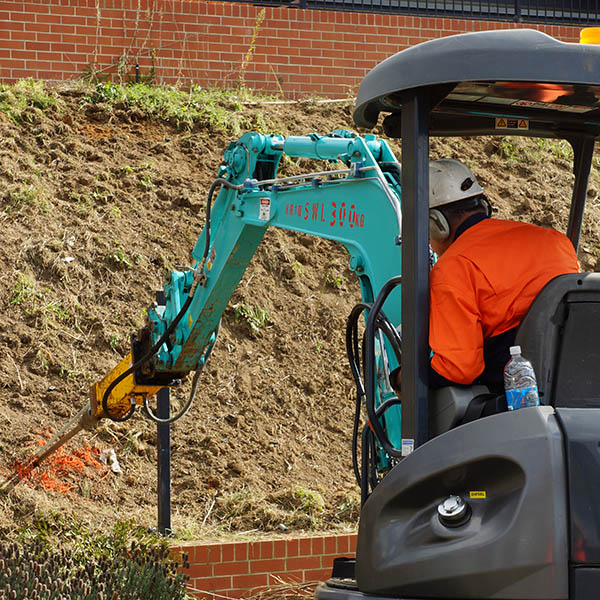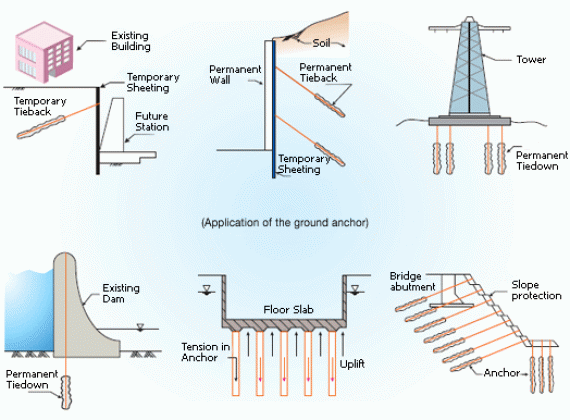Manta Ray anchors: Used to Secure Marinas Worldwide
Wiki Article
Exactly How Durable Earth Anchors Work: A Comprehensive Guide to Soil Anchoring Solutions
Sturdy Earth anchors play a crucial function in supplying stability and support in various building and construction applications. By installing deeply right into the ground, they stand up to vertical and side pressures successfully. Various sorts of anchors provide to different dirt conditions, making them functional. Understanding their mechanics and installment strategies is essential for optimizing efficiency. What variables affect their performance, and exactly how do they contrast to standard techniques? The answers might amaze you.Recognizing Sturdy Earth Anchors
Heavy-duty Earth supports serve as important parts in different construction and landscape design projects, offering stability and support in tough soil conditions. These anchors work by being installed into the ground, where they resist side and vertical pressures. Their style enables for safe accessory to frameworks, ensuring they continue to be secured against dirt movement or outside loads.The performance of heavy-duty Earth anchors mostly relies on the kind of dirt and the anchor's installment depth. Proper installation methods are vital, as they determine the support's holding capability. Ecological factors, such as moisture and freeze-thaw cycles, can additionally influence performance.These supports are regularly used in applications ranging from securing fences and preserving wall surfaces to maintaining short-term frameworks throughout unfavorable weather conditions. Recognizing the concepts behind sturdy Earth supports is necessary for experts seeking to improve the sturdiness and safety of their tasks.Sorts Of Heavy-Duty Earth Anchors
Various sorts of heavy-duty Earth supports are developed to satisfy particular requirements based on dirt problems and job demands. Helical anchors, featuring screw-like blades, work in softer dirts, providing high lots capabilities and very easy installment. Driven supports, which are hammered right into the ground, appropriate for rocky terrains and supply instant lots assistance. Tie-back supports are commonly made use of in retaining wall applications, enabling for side support by securing right into the ground at an angle. Another type is the cast-in-place support, perfect for concrete applications, as they are integrated into structures for improved stability. Finally, soil screw supports are functional choices that can be made use of in various soil kinds, supplying reliable tension and compression abilities. Each kind offers distinctive applications, guaranteeing security and security in building and landscaping tasks. Comprehending these options enables educated choices in picking the proper Earth anchoring service.The Mechanics of Dirt Anchoring

Comprehending the mechanics of dirt anchoring requires an evaluation of various kinds of Earth anchors and their installment methods. Each anchor kind provides unique features that affect its performance in different dirt conditions. Correct installment techniques are necessary for maximizing the securing system's stability and efficiency.
Sorts Of Earth Anchors
Earth supports, crucial parts in soil anchoring systems, come in several types, each developed for details applications and soil problems. One of the most usual types include screw anchors, which are turned right into the ground, offering solid lateral resistance. Helical supports feature blades that permit effective installation in numerous soil kinds, making them suitable for both long-term and short-term applications. Driven anchors, commonly made from steel, are inculcated the dirt and are reliable in dense or rough settings. Auger anchors make use of a helical style to assist in installation in softer soils. Plate anchors are composed of a flat plate buried flat, distributing lots over a larger area, ideal for applications requiring high tons capacities in natural dirts.Installation Techniques Explained
Appropriate setup strategies are essential for the performance of dirt anchoring systems. The process generally begins with site evaluation, confirming the chosen location can support the anchor's load. After determining the right anchor kind, correct opening depth and angle must be established. The installation involves driving the anchor right into the ground making use of specific devices, such as hydraulic or hand-operated motorists, to attain finest embedment. Post-installation, tensioning the anchor is essential to guarantee stability; this is frequently confirmed with load testing. Furthermore, bordering dirt problems should be kept an eye on to stop displacement. Adhering to these methods not just boosts the anchor's efficiency but also lengthens its lifespan, giving trustworthy assistance for various applications.Applications of Heavy-Duty Earth Anchors
While durable Earth supports are frequently related to building and landscape design, their versatility encompasses a range of applications across different sectors. In civil engineering, they offer essential assistance for keeping walls, ensuring stability in locations susceptible to dirt disintegration. The marine market utilizes these supports for protecting docks and marinas, protecting against activity created by currents and trends. Additionally, in the telecom sector, sturdy Earth supports are significant for maintaining cell towers and various other high frameworks against wind pressures. Agricultural applications additionally profit, as these anchors can protect frameworks like greenhouses and livestock fencing, ensuring they stand up to severe weather. In addition, in renewable resource tasks, such as wind ranches, Earth anchors play a crucial function in securing generator foundations, boosting total safety and performance. This wide series of applications highlights the versatility and reliability of sturdy Earth anchors throughout numerous areas.Advantages Over Conventional Anchoring Approaches
Although standard anchoring methods have actually long been trusted for stability, sturdy Earth supports offer considerable advantages that enhance performance and efficiency. One significant benefit is their remarkable load-bearing capability, which allows them to hold up against better forces without failing. This strength makes them suitable for demanding applications, such as in building and energy installations.Additionally, heavy-duty Earth supports are developed for deeper installation, providing better security in numerous soil problems, consisting of sandy or loosened dirts. Their resistance to rust and ecological aspects assures a longer life expectancy and lowered maintenance expenses contrasted to standard methods.Moreover, these supports can be set up with very little disturbance to the surrounding area, maintaining the stability of the landscape. On the whole, sturdy Earth anchors provide a reputable and effective solution for anchoring demands, surpassing the limitations usually related to typical anchoring methods.Installation Refine and Finest Practices
The setup procedure for dirt securing options begins with comprehensive prep work and website analysis to other ensure peak efficiency. Following this, a step-by-step installation overview provides clear guidelines for effective implementation (soil anchoring solutions). Abiding by these ideal practices is important for attaining trustworthy and long-lasting anchoring resultsPreparation and Website Evaluation
Efficient prep work and comprehensive website assessment are important action in the installment of soil learn this here now securing solutions. Prior to setup, the dirt kind have to be examined to establish its bearing ability and suitability for anchoring. Performing a geotechnical survey can provide important details concerning dirt make-up, wetness levels, and potential ground movement. Furthermore, recognizing existing structures, vegetation, and utilities is vital to stay clear of disturbance throughout installation. The location ought to be removed of particles and obstacles to assure safe gain access to for tools. Weather need to also be monitored, as negative problems can impact both safety and installment efficiency. By diligently preparing the website and examining all relevant aspects, the probability of effective anchor efficiency is considerably raised.Step-by-Step Setup Overview
A thorough installation procedure is important for accomplishing optimal performance of soil securing solutions. The installation starts with selecting the ideal support kind and guaranteeing the site is free from particles. Next, appropriate hole positioning is established based on lots requirements. Once the area is established, holes are drilled to the defined depth and diameter utilizing the proper devices. The anchor is after that inserted into the opening, ensuring it is aligned appropriately. After protecting the support, soil is backfilled and compacted to boost security. It is necessary to adhere to supplier guidelines throughout the process. A post-installation evaluation confirms that the supports are properly positioned and working as meant, offering trustworthy support for the intended application.
Upkeep and Evaluation of Earth Anchors
Normal upkeep and examination of Earth supports are crucial for ensuring lasting efficiency and security. Routine checks permit the early detection of issues such as rust, loosening up, or dirt activity. Assessors need to try to find indications of rust or degradation on the anchor elements, specifically at the connection factors. Additionally, the surrounding dirt must be examined for disintegration or adjustments in dampness web content, which can influence support effectiveness.It is advisable to develop a routine assessment timetable, preferably a minimum of annually, depending upon environmental conditions. Throughout evaluations, all noticeable components must be cleaned up to get rid of dust or particles that can hide prospective problems. Any indicators of distress, such as tilting frameworks or uncommon settling, need to prompt instant analysis. Correct documents of examinations can aid in tracking anchor efficiency with time and facilitate prompt maintenance activities, click making sure the supports stay practical and trusted.Frequently Asked Inquiries
What Materials Are Heavy-Duty Earth Anchors Commonly Made From?
Sturdy Earth anchors are generally created from sturdy products such as galvanized steel or stainless steel, making certain toughness and resistance to deterioration. These products offer long-lasting assistance and security in numerous soil conditions and applications.Just How Do Soil Problems Influence Support Efficiency?
Soil conditions substantially influence support performance. Aspects such as soil kind, wetness web content, and compaction influence the support's hold and security, with cohesive dirts usually offering far better resistance than loose or sandy dirts, affecting total performance.
Can Heavy-Duty Earth Anchors Be Recycled After Elimination?
Sturdy Earth supports can be recycled after removal, provided they are examined for damage and wear. Proper cleansing and upkeep improve their durability, ensuring reliable performance in subsequent installments when problems allow for secure reinstallation.What Are the Environmental Impacts of Making Use Of Earth Anchors?
The ecological impacts of using Earth supports consist of potential dirt disturbance, disturbance of local environments, and feasible contamination of groundwater. Nonetheless, if made use of responsibly, their advantages typically exceed these worries, advertising security in different applications.How Do I Pick the Right Support for My Task?

Report this wiki page